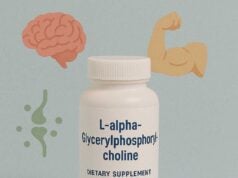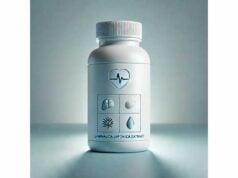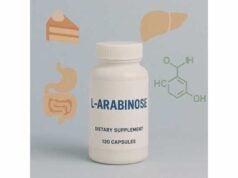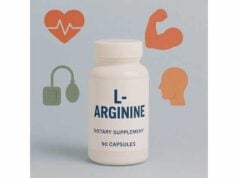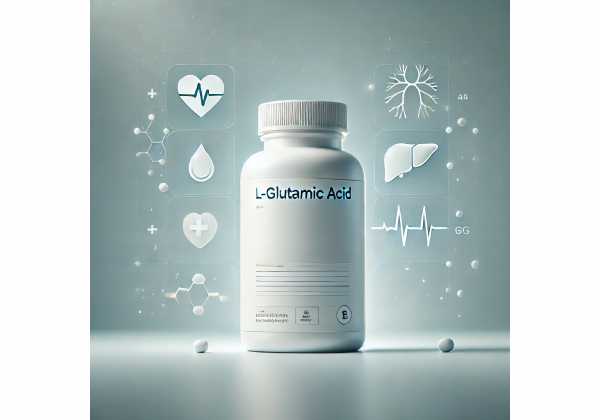
L-glutamic acid—often shortened to glutamate when it appears in its ionized form—is a conditionally nonessential amino acid central to how your body turns food into energy and how your brain cells communicate. It’s the most abundant excitatory neurotransmitter in the central nervous system, helping encode learning and memory. In everyday life you meet glutamate in two ways: bound inside protein-rich foods (meat, fish, legumes, dairy) and as “free glutamate,” including the seasoning monosodium glutamate (MSG), which boosts savory umami flavor. As a supplement, L-glutamic acid appears in amino acid blends, protein powders, and specialized sports formulas. It’s also used in medical nutrition when clinicians need precise amino acid mixtures. This guide clarifies where L-glutamic acid can be helpful, where claims outpace evidence, how to use it wisely if you choose to supplement, and who should avoid it. You’ll also learn about dosage ranges used in practice, typical timing, common side effects, and how regulatory bodies view dietary exposure and safety.
Quick Overview
- May support cognitive function indirectly by fueling neurotransmission and synaptic plasticity.
- Enhances savory flavor when used as MSG; most people tolerate typical intakes without issues.
- Typical supplemental range: 1–3 g/day; food-additive safe intake benchmark: 30 mg/kg/day (as glutamic acid).
- Avoid self-supplementation if you have epilepsy, untreated mood or neurodegenerative disorders, or are on glutamatergic drugs.
Table of Contents
- What it is and how it works
- Proven and possible benefits
- How to use it in practice
- Factors that change response
- Dosage: how much and when
- Safety: who should avoid it
- What the evidence says
What it is and how it works
L-glutamic acid is one of the twenty amino acids that build proteins. In cells, it sits at the crossroads of carbon and nitrogen metabolism: it donates amino groups to make other amino acids, feeds into the citric acid cycle as α-ketoglutarate, and helps shuttle nitrogen for safe disposal. In the brain, glutamate’s role is more specialized and tightly regulated. Neurons package glutamate into vesicles and release it into the synaptic cleft to pass signals. It binds to ionotropic receptors (AMPA, NMDA, kainate) and metabotropic glutamate receptors (mGluRs), opening channels and triggering cascades that underlie synaptic plasticity—the cellular basis of learning and memory.
Despite its central role in the brain, dietary glutamate does not simply “pour into” the nervous system. Your intestinal cells use glutamate as a preferred fuel, and the blood–brain barrier maintains strict control over glutamate levels in the central nervous system. Most brain glutamate is made locally from glutamine supplied by astrocytes (the glutamate–glutamine cycle). This matters when evaluating supplements and MSG: typical dietary intakes mainly affect the gut and systemic amino acid pools, not synaptic concentrations in a direct, one-to-one fashion.
In foods, glutamate exists both bound in proteins and as “free” glutamate. Free glutamate is responsible for the umami taste—strongly present in tomatoes, aged cheeses, mushrooms, fermented foods, and broths. MSG is the sodium salt of L-glutamic acid and acts like free glutamate to enhance savory flavor with less sodium by weight than table salt.
In medical settings, defined mixtures of amino acids—including L-glutamic acid or glutamate equivalents—are used for parenteral nutrition, metabolic studies, or when clinicians need to tailor formulas for specific conditions. In sports nutrition, L-glutamic acid is often a background component of protein or essential amino acid blends rather than a standalone star, because performance outcomes relate more clearly to total protein quality, leucine content, and overall energy intake.
Key takeaway: L-glutamic acid is metabolically indispensable and neurobiologically essential, but the body keeps tight control over where and how it acts. That’s why benefits (and risks) depend on context—dietary pattern, total protein intake, health status, and formulation.
Proven and possible benefits
1) Flavor and appetite satisfaction (culinary use). Free glutamate, including MSG, reliably enhances umami and can improve palatability at lower sodium levels compared with salt alone. For people reducing sodium, using umami-rich ingredients or small amounts of MSG in savory dishes can maintain flavor satisfaction while cutting total sodium. This is a culinary benefit, not a metabolic one, but it often drives interest in “glutamate.”
2) Neurotransmission and learning (physiological role, not a shortcut). Glutamate is the principal excitatory neurotransmitter. Adequate dietary protein supports the brain’s glutamate–glutamine cycle, which underpins synaptic plasticity. However, ingesting extra glutamate does not directly boost cognition the way caffeine acutely boosts alertness. Any cognitive support is indirect, via overall protein adequacy, balanced diet, good sleep, and metabolic health.
3) Gut fuel and GI integrity (emerging relevance). Enterocytes—the cells lining your small intestine—use glutamate as an oxidative fuel. In animal and mechanistic studies, dietary glutamate can support mucosal health and gut–brain signaling pathways. In humans, practical significance seems greatest when protein intake is marginal, during recovery from illness, or when specialized medical formulas are used under supervision.
4) Sports and recovery (supportive but not primary). In athlete diets with sufficient high-quality protein (1.6–2.2 g/kg/day), there’s little evidence that adding isolated L-glutamic acid outperforms whole-protein or essential-amino-acid blends. Because glutamate is abundant in dietary proteins, meeting overall protein targets is generally more impactful than targeting free glutamate.
5) Taste-guided nutrition strategies. For people with poor appetite or taste fatigue—older adults, patients in rehabilitation—umami enhancement can make nutrient-dense foods more appealing. This can indirectly improve protein and energy intake, though the effect depends on the individual and meal context.
What is not well supported? Claims that L-glutamic acid supplements alone “increase IQ,” “sharpen memory,” or “detoxify the brain” overstate what diet can do. Similarly, using supplemental glutamate to “balance neurotransmitters” lacks clinical proof in healthy adults. Because the nervous system regulates glutamate tightly and because excitotoxicity is a risk when synaptic clearance fails, more isn’t necessarily better.
Bottom line: L-glutamic acid is essential in biology and useful in the kitchen; as a standalone supplement, its benefits are modest and context-dependent. Prioritize adequate total protein, whole foods, sleep, training, and medical guidance when relevant.
How to use it in practice
Start with your dietary baseline. If you eat protein at most meals—fish, eggs, dairy, soy, legumes, meats—you already consume large amounts of bound glutamate within those proteins. Many savory foods (tomatoes, mushrooms, seaweed, aged cheeses, fermented sauces) provide free glutamate for umami. For most healthy adults, this foundation is sufficient.
If you’re considering culinary use, MSG or umami-rich ingredients can make low-sodium cooking more satisfying. Practical approach:
- Build flavor with stocks, tomato paste, mushrooms, seaweed, or aged cheese.
- If needed, add a small pinch of MSG to soups, stews, and stir-fries in place of some salt.
- Taste and adjust; you need less than you think.
If you’re considering supplement use, first ask what you’re trying to fix. For athletes, the focus should be total protein intake, protein distribution (0.3–0.4 g/kg per meal, spaced 3–4 times daily), and leucine content for muscle protein synthesis. In that context, adding isolated L-glutamic acid rarely changes outcomes. For individuals in clinical nutrition scenarios—poor appetite, post-operative recovery, or specific metabolic needs—formulas sometimes include defined amounts of glutamate as part of a balanced amino acid profile. Those choices belong with your clinician or dietitian.
For cognition, the best “glutamate strategy” is indirect: maintain protein adequacy, support metabolic health, manage stress, and protect sleep. Supplements marketed as “neuro-glutamate boosters” should be viewed skeptically unless a clinician recommends a targeted protocol.
Finally, consider cost and simplicity. If a supplement adds expense without a clear, measurable benefit, put that budget toward higher-quality staples (seafood, dairy, legumes, eggs) or toward habits that move the needle (training plans, sleep hygiene).
Practical indicators you’re on track:
- You meet daily protein needs without GI distress.
- Meals taste satisfying even with moderate sodium.
- No new headaches, flushing, or palpitations after umami-enhanced meals.
- If under medical care, your care team signs off on any formula changes.
Factors that change response
1) Health status of the nervous system. Glutamate signaling is fundamental to brain function, but dysregulation lives on both sides of the curve. People with epilepsy, certain neurodegenerative diseases, or acute brain injuries can be vulnerable to excitotoxicity—a harmful overactivation of glutamate pathways. In those settings, self-supplementation is inappropriate.
2) Gut function. Because intestinal cells avidly metabolize glutamate, malabsorption, inflammation, or major GI surgery can change how oral glutamate is used. In clinical care, dietitians may adjust amino acid profiles in enteral or parenteral formulas accordingly.
3) Total diet pattern. Adequate dietary protein, micronutrient sufficiency (especially B-vitamins), and balanced carbohydrate intake matter more to neurotransmitter balance than any one amino acid. Ultra-low-protein diets, crash dieting, or heavy alcohol use can distort amino acid handling and nitrogen balance.
4) Sodium and taste thresholds. MSG contains about one-third the sodium of table salt by weight. Individuals vary in how they perceive umami and in how sodium reduction affects palatability. For some, a modest MSG substitution helps lower sodium without sacrificing satisfaction; others may notice little difference.
5) Medications and supplements. Agents that act on glutamatergic pathways (for example, NMDA antagonists like memantine or ketamine) or on seizure thresholds warrant extra caution with any supplement that could alter excitatory–inhibitory balance. Stimulants, certain antidepressants, and substances of misuse can also interact indirectly by changing neuronal excitability, sleep, or appetite.
6) Age and training status. Older adults often benefit from higher protein targets to counter anabolic resistance. In that context, getting enough total protein and leucine is more impactful than adding isolated glutamate. For athletes, training volume, energy availability, and hydration dictate recovery far more than a single amino acid.
7) Individual sensitivity. A small subset of people report short-lived symptoms (headache, flushing, palpitations, nausea) after large boluses of MSG without food. These reactions are uncommon, typically mild, and dose-dependent. Eating MSG within mixed meals lowers the chance of symptoms.
Dosage: how much and when
There is no universal “therapeutic dose” of isolated L-glutamic acid for healthy adults, and for most goals it is unnecessary. Practical ranges used in supplements and culinary contexts look like this:
- Supplemental L-glutamic acid (standalone): 1–3 g/day, usually split across meals. This is a common range in multi-amino-acid blends rather than a target dose with proven unique benefits.
- Protein blends and whole foods: Emphasize total daily protein (about 1.2–2.0 g/kg/day for active adults; 1.6–2.2 g/kg/day during fat loss or heavy training). These intakes naturally supply substantial glutamate within proteins.
- Culinary MSG: Typical servings in prepared foods supply <0.5 g per portion. When seasoning home cooking, start with a small pinch (for example, 1/8 teaspoon for a pot of soup) and adjust to taste.
For safety benchmarking, European risk assessors derived a group acceptable daily intake (ADI) of 30 mg/kg/day as glutamic acid for glutamates used as food additives. That figure applies to added free glutamate exposure from additives, not to glutamate bound within normal dietary proteins. Still, it’s a useful guardrail when you regularly season with MSG or consume many heavily flavored processed foods.
Timing: If you do use an L-glutamic acid supplement, take it with meals to slow absorption and reduce the chance of transient symptoms. For culinary use, integrate MSG into simmered dishes so it dissolves evenly.
Stacking: Combining glutamate with caffeine or high-dose stimulants is unnecessary and can increase jitteriness in sensitive individuals. Pairing with magnesium glycinate or protein at meals is neutral and often helpful for appetite and overall nutrition.
Measuring benefit: Choose simple, observable outcomes—meal enjoyment on lower sodium, easier adherence to high-protein targets, no adverse symptoms. If nothing improves after two to four weeks, discontinue.
Safety: who should avoid it
Most people tolerate typical dietary and culinary amounts of glutamate without problems. Reported short-term reactions to large, fasting boluses of MSG include headache, flushing, tingling, drowsiness, palpitations, and nausea; these are uncommon, generally mild, and fade within hours. Eating MSG within mixed meals lowers the risk of symptoms.
Who should avoid self-supplementation or seek medical advice first:
- Epilepsy or seizure disorders. Altered excitatory–inhibitory balance can increase risk; do not add isolated glutamate without specialist guidance.
- Neurodegenerative disease, traumatic brain injury, or active neurological symptoms. Excitotoxicity is a mechanistic concern; discuss any supplement plans with your neurologist.
- Uncontrolled anxiety, bipolar disorder, or psychosis. Glutamatergic pathways intersect with mood and perception; involve your psychiatry team.
- Use of glutamatergic medications. This includes NMDA receptor antagonists (e.g., memantine, ketamine/esketamine) and investigational agents targeting mGluR or AMPA pathways.
- Severe GI disease or recent GI surgery. Absorption and utilization may differ; coordinate with your gastroenterology and nutrition teams.
- Infants and children. Do not give isolated glutamate supplements unless prescribed; meet needs through balanced diets.
Interactions and precautions:
- Caffeine and stimulants: May amplify palpitations or jitteriness in sensitive users.
- High sodium diets: MSG contains sodium, though less than table salt. If you must restrict sodium strictly, count total sodium from all sources.
- Allergy and intolerance: True allergy to glutamate is exceedingly rare; most reactions are non-allergic sensitivity to large boluses taken without food.
Pregnancy and lactation: Stick to dietary sources; avoid isolated glutamate supplements unless your clinician recommends a specific formula.
Driving rule: If you experience neurological symptoms (confusion, severe headache, visual changes) after any supplement or very high-glutamate meal, seek medical care and discontinue use.
What the evidence says
Across authoritative reviews, three themes emerge:
- Physiology is clear and non-controversial. Glutamate is the primary excitatory neurotransmitter and is essential for synaptic plasticity. The brain manufactures and recycles its own glutamate via the glutamate–glutamine cycle, with astrocytes playing a central role. These fundamentals underpin both normal cognition and many neurological disease models.
- Dietary safety at typical intakes is well supported. Regulatory reviews of glutamic acid and its salts as food additives concluded that a daily intake of 30 mg/kg/day as glutamic acid is an appropriate benchmark for added free glutamate exposure. Typical consumer exposure to added MSG is far lower than total glutamate intake from protein in foods, and most people do not experience adverse effects at normal dietary levels. A small subset reports transient symptoms after large, fasting boluses.
- Supplements are rarely necessary for healthy adults. Evidence that isolated L-glutamic acid improves cognition, mood, or athletic performance in already well-nourished people is limited. Benefits are more compelling in culinary and clinical-nutrition contexts: improving flavor to support lower-sodium diets or appetite, and as part of defined medical formulas managed by clinicians.
The nuance: Excitotoxicity—neuronal injury due to excessive glutamatergic activation—remains a core mechanism in acute and chronic neurological disorders. That’s a disease-mechanism issue, not a green light to “treat with glutamate.” It’s precisely why unmonitored high-dose supplementation is discouraged in people with neurological conditions.
What to watch next: Ongoing research probes how glutamatergic drugs (antagonists, modulators) and transporter-targeting strategies might help conditions from depression to neurodegeneration. Diet will remain supportive: meeting protein needs, protecting metabolic health, and using culinary umami wisely to maintain enjoyable, lower-sodium eating patterns.
References
- Questions and Answers on Monosodium glutamate (MSG) 2018 (Guidance/FAQ)
- EFSA reviews safety of glutamates added to food 2017 (Regulatory Summary)
- Biochemistry, Glutamate 2022 (Overview)
- A review of the alleged health hazards of monosodium glutamate 2019 (Systematic Review)
- Glutamate-Mediated Excitotoxicity in the Pathogenesis and Treatment of Neurodevelopmental and Adult Mental Disorders 2024 (Narrative Review)
Disclaimer
This article is for educational purposes only and is not a substitute for personalized medical advice, diagnosis, or treatment. Always talk with a qualified healthcare professional before starting, stopping, or changing any supplement, medication, or nutrition plan—especially if you have a neurological condition, take prescription drugs, are pregnant or breastfeeding, or are planning surgery. If you experience concerning symptoms after using any product discussed here, seek medical care promptly.
If you found this guide helpful, consider sharing it with a friend or colleague on Facebook, X (formerly Twitter), or your preferred platform, and follow us on social media. Your support helps us continue creating clear, balanced health content.

